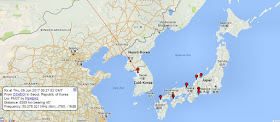 |
| Screenshot from part of the experiment... |
I'm planning to use a small webcam as well. You can get the image with the command "pe4bas% w".
Will try to setup some files for experimental download (if someone wishes).
However, remember this happening some years ago, I will not be on the keyboard most of the time as I've other things to do this weekend. I might occasionally log in on remote to view any results.
I've been testing with G3CWI Richard from England on 30m FSQ last wednesday evening. We had a very reliable connection although sometimes RTTY trying to interfere. We did some tests with relaying, chat mode and picture sending. At least a shortcoming of the chat mode was discovered. And I didn't get the program to start receiving a picture automatically, not shure if it is my fault?
Chatfunction:
It is important to first click the call in the heard list, then type your message so your message will show up in the chatscreen, otherwise you can only read it in the monitor screen. The problem however is that when you have typed part of your message and are transmitting that, everything you type while transmitting is not showing in the chatscreen. We found that it is a shortcoming of the software.
Receiving:
You can get best results with receiving FSQ if you apply a small filter. Like a 350Hz CW filter. Just letting the signal through and nothing else. Richard told me that with AGC off on the radio it seems to be better as well, at least he had better results.
Relay:
We tested the relay function, it works well. Don't forget to address it with the call you want to send your message to. See....the manual.
If you like, jump into the FSQ network. Just to experiment...hope to see some of you in my heard list.




















